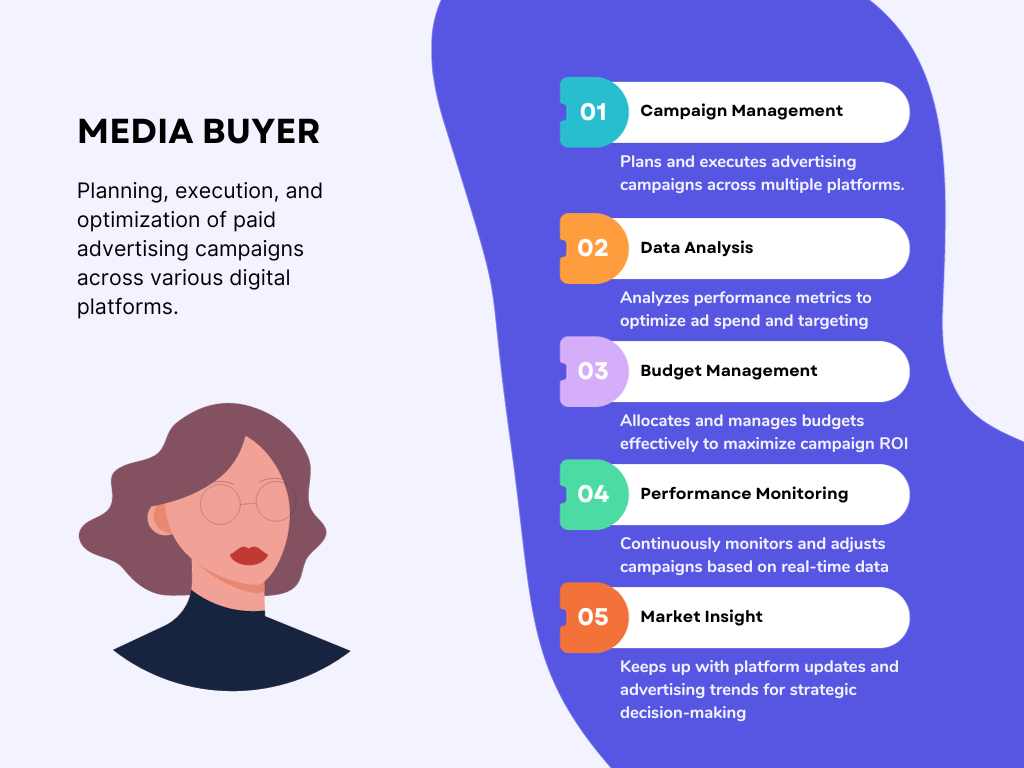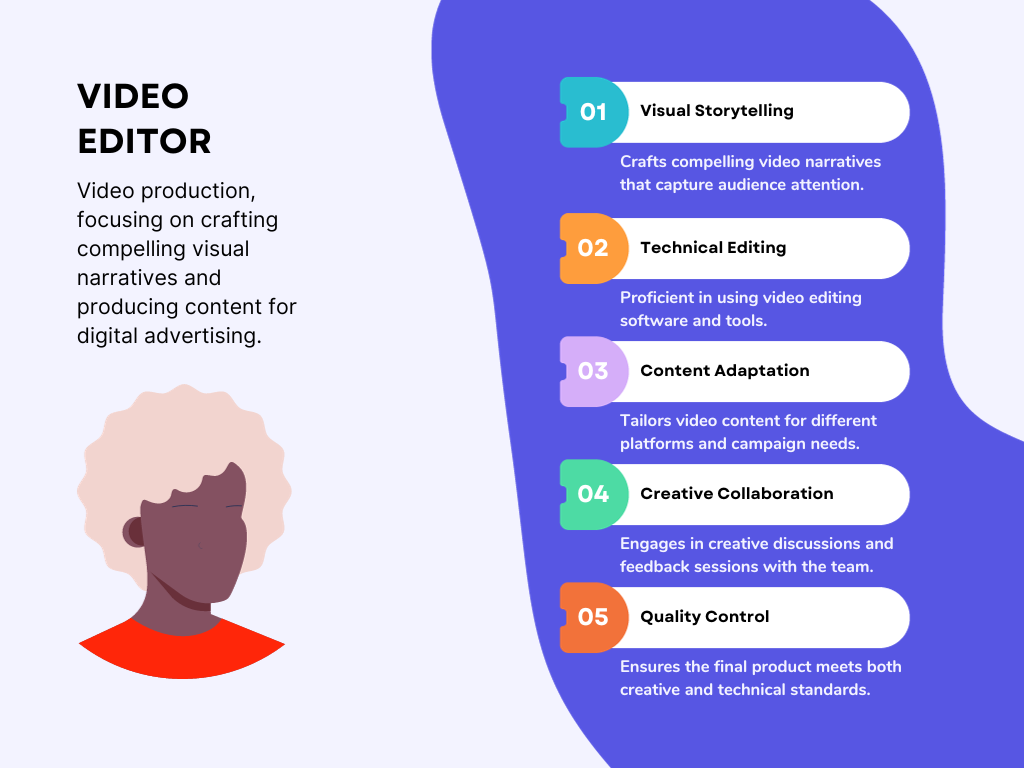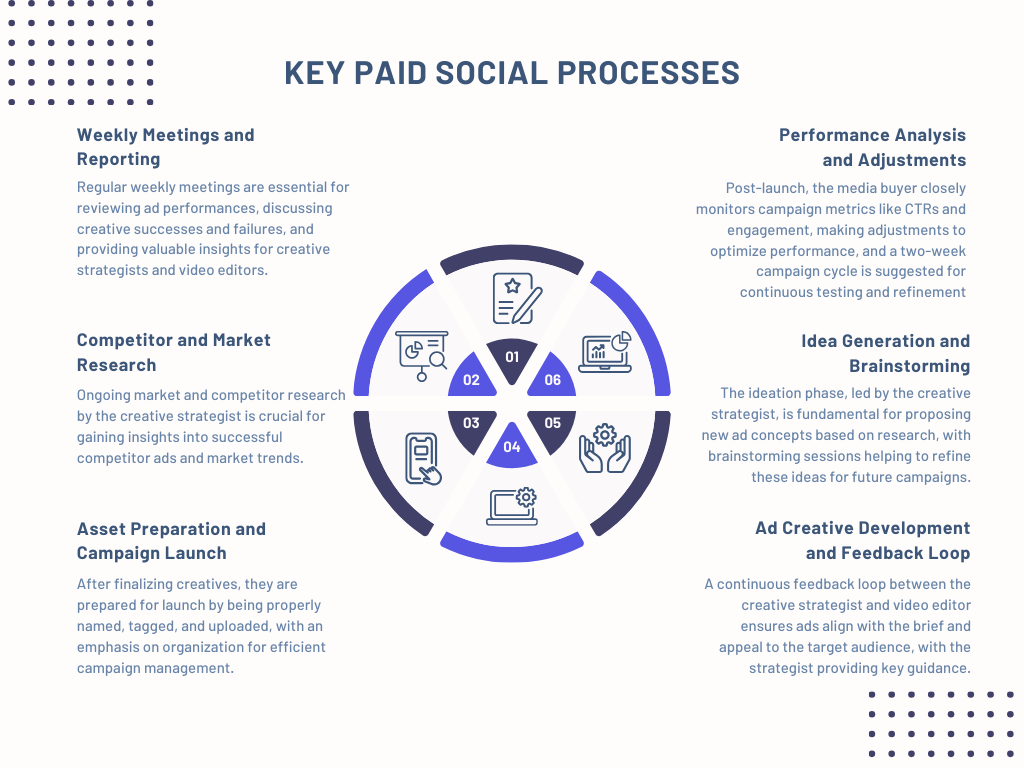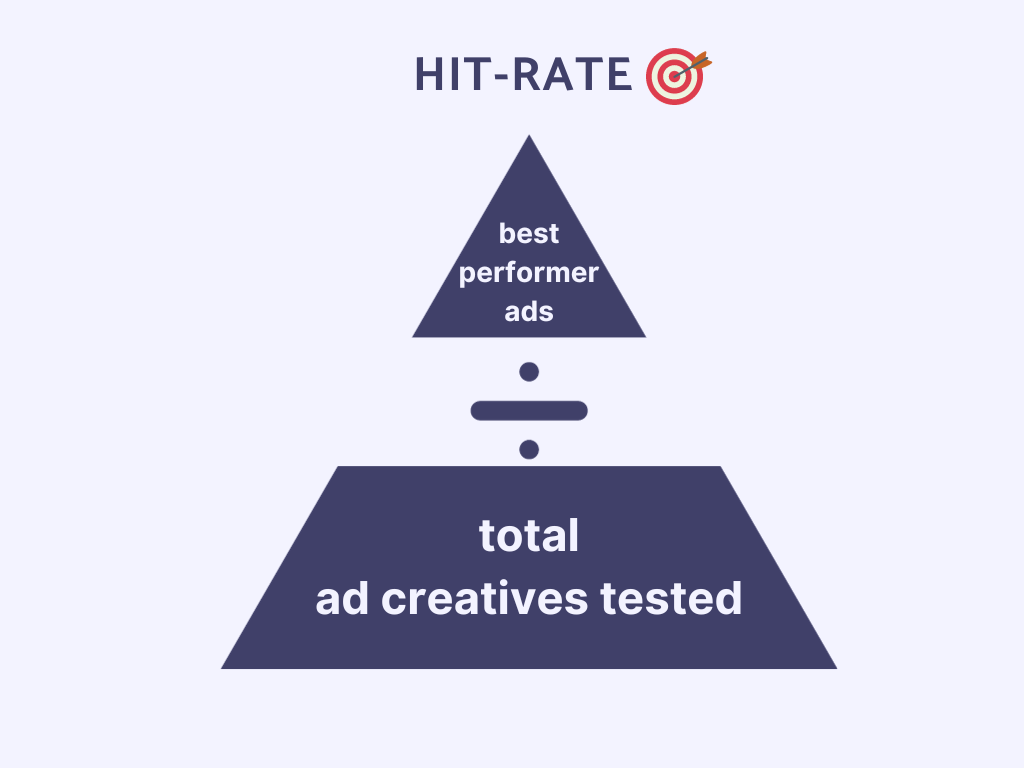Paid Social Blueprints
How to build a superstar paid social team
Building a superstar paid social team goes beyond just gathering talent. It demands a strategic approach to defining roles, streamlining processes, and setting clear goals. This guide provides essential insights and practical strategies for anyone looking to create or enhance a paid social team, covering everything from role identification to efficient workflow development and the integration of technology. Perfect for startups, experienced media buyers, or new team leads!
Intro
Building a successful paid social team is no simple task, even if you are a paid social expert yourself. It involves more than just bringing together skilled individuals. It demands a strategic approach to defining roles, setting up processes, and establishing clear goals. Whether you are a founder of a new startup, an experienced media buyer, or a newly appointed team lead, it's crucial to build the paid social team to achieve your business goal.
This guide has been specifically designed to assist you in navigating the complex process of assembling a paid social team. Whether you are creating a team from the ground up or looking to enhance an existing one, this guide provides essential insights and strategies. We'll cover everything from identifying key roles such as media buyers and creative strategists to developing streamlined workflows and measurable performance indicators. Our goal is to help you build a team that not only possesses the necessary skills but also works together harmoniously to achieve great results!
Defining an Efficient Paid Social Team
The effectiveness of a paid social team is not just measured by its headcount, but by its operational efficiency. It's about the clarity and precision of each member's role and responsibilities. A team, regardless of its size, should have a structure where each member knows exactly what they're accountable for. This is essential, whether it’s in creative testing, media buying, reporting, or feedback processes.
In a well-defined team, everyone has a specific 'hat' to wear – a set of tasks and responsibilities that they own. The roles might vary based on the company's size, ad spend, and the volume of creative content required. For instance, in smaller setups, you might find team members juggling multiple roles, like a media buyer who also acts as a creative strategist. However, in larger teams, these roles become more specialized.
An efficient team isn't just about having people fill positions. It's about establishing a process that's smooth and clear, equipped with the right tools and a solid understanding of who owns each part of the process. This approach minimizes wasted time, ensures clearer handoffs, and promotes a rhythm of work that aligns with the team's goals. Ultimately, the efficiency of a paid social team lies in the harmony of its members working towards a common objective, each contributing their expertise to the overall success of the team.
Essential Roles in a Paid Social Team
The composition of your team can make or break the success of your campaigns. Understanding the essential roles within a paid social team is crucial, as each member plays an important role in driving the overall strategy and execution of your advertising efforts.
Media Buyer
The media buyer, sometimes referred to as a performance marketer, is a foundation of the paid social team. This role involves more than just purchasing impressions, it requires a deep understanding of various platforms and the ability to launch and manage campaigns effectively. The media buyer is responsible for the results of these campaigns, ensuring that successful ads are scaled and underperforming ones are adjusted or ceased. This role demands a keen eye for detail, analytical skills, and the ability to make swift, informed decisions based on campaign performance data.

Creative Strategist
In many teams, especially smaller ones, the creative strategist often wears multiple hats, combining the roles of a media buyer and a creative. But the role of creative strategy in a paid social team is so important, that if you have a chance to hire just one superstar into your team, we’d say it should be a creative strategist. A creative strategist brings to the table a unique blend of understanding both the brand and the nuances of social media platforms, making their role crucial in driving the success of ad campaigns.
The role of creative strategy in a paid social team is so important, that if you have a chance to hire just one superstar into your team, we’d say it should be a creative strategist.
A creative strategist is tasked with knowing the ins and outs of various ad platforms and the environments where ads are displayed. Their job is to ideate, create strategies that resonate with the target audience, and ensure that the ads align with the brand's voice and objectives. This role requires a deep understanding of what's currently working in the market, knowledge of competitors, and the ability to anticipate trends.
In smaller companies or teams, the creative strategist often combines roles – they might handle aspects of media buying while simultaneously developing creative concepts. In larger teams, this role becomes more specialized, focusing solely on creative ideation and strategy.
The creative strategist plays a critical role in the feedback loop, especially in teams where roles like media buying and video editing are distinct. They provide direction and feedback to those creating the ads – whether it's video content, ad copy, or overall campaign themes. Their insights ensure that the creatives are not just high-quality but also are likely to achieve the desired objectives.

Video Editor
With the growing importance of video content in digital advertising, the video editor plays a critical role in the team. They are responsible for creating compelling video content that captures the audience's attention and effectively communicates the product's value. This role involves editing existing materials like user-generated content, raw footage, and stock footage, and creatively combining these elements with music, overlays, and other enhancements to produce engaging and effective ads. In smaller companies, this role might be merged with that of the media buyer or creative strategist, but as the team grows, it becomes a specialized and vital function.

Feeeback Loop, Team Size and Personal Growth
An important component of an efficient paid social team is the feedback loop, especially between the media buyer and the video editor. Clear and continuous communication ensures that the creatives align with the campaign's goals and adapt based on performance data. This loop is essential for refining strategies and maximizing the impact of each ad.
The structure of the team often varies depending on the company's size and ad budget. In a smaller setup, you might find one person managing multiple roles, while in larger organizations, these responsibilities are distributed among specialized individuals. The key is to maintain a balance between creative ideation, technical execution, and performance analysis, regardless of the team's size.
Building a stellar paid social team requires a strategic approach to role assignment. Each member, from the media buyer to the creative strategist and video editor, plays a unique role in crafting and executing a successful advertising strategy. Ensuring clear responsibilities, fostering collaboration, and adapting roles to fit the team's size and budget are essential steps in creating a team that works harmoniously to achieve outstanding results in the competitive world of paid social advertising.
Key processes and workflows
Establishing key processes and workflows is fundamental to the success of your team. These processes not only streamline operations but also ensure that every team member is aligned with the overall strategy and objectives. An efficient workflow facilitates clear communication, effective handovers, and ultimately, high-performing campaigns.

Weekly Meetings and Reporting
A critical process in managing a paid social team is holding regular meetings, preferably weekly. These meetings are opportunities to review current ad performances, discuss successful and underperforming creatives, and align on the upcoming strategy. These meetings should focus on analyzing what ads are performing well, identifying trends, and understanding why certain creatives resonate with the audience. This information is invaluable for the creative strategists and the video editors, as it informs their future creations.
Competitor and Market Research
Regular market and competitor research are essential tasks for the creative strategist. This research provides insights into successful ads from competitors, market trends, and potential new creative ideas that could be adapted to your brand. Keeping a pulse on the market ensures that your team's strategies remain relevant and innovative.
Idea Generation and Brainstorming
A core part of the team's workflow is the ideation phase. Here, the creative strategist plays a crucial role in proposing new advertising concepts based on their research. Brainstorming sessions can be beneficial, allowing the team to refine these ideas collectively and agree on the creative direction for upcoming campaigns.
Ad Creative Development and Feedback Loop
Once new ideas are agreed upon, the video editor begins creating the ads. During this phase, a constant feedback loop between the creative strategist and the video editor is vital. This loop ensures that the creatives are aligned with the brief and are likely to resonate with the target audience. The creative strategist provides guidance and feedback, ensuring the final ad is both high quality and strategically sound.
Asset Preparation and Campaign Launch
After the creatives are finalized, they are prepared for launch. This involves ensuring that all assets are correctly named, tagged, and uploaded to the necessary platforms. Naming conventions and organization are crucial here to avoid confusion and ensure efficient campaign management.
Performance Analysis and Adjustments
Once the campaigns are live, the media buyer monitors their performance closely. This involves analyzing metrics such as CTRs, engagement, and conversion rates. Based on this data, the media buyer makes adjustments to optimize the campaign’s performance. This could mean reallocating budget, tweaking targeting parameters, or swapping out underperforming creatives.
Implementing a two-week cycle can be an effective approach. In this model, new campaigns are launched every other week, allowing for a continuous flow of testing, analysis, and refinement. This cycle ensures that there is always fresh content in the market, and learnings from one cycle can be quickly applied to the next.
Goal Setting and Performance Metrics
Two essential metrics for a paid social team are ad volume and hit rate.
Effective goal setting and performance metrics will provide a clear direction but also serve as benchmarks for evaluating the team's performance and the impact of their campaigns. These goals should be specific to each team member's role and aligned with the broader objectives of your marketing strategy. For instance, a media buyer might have goals related to campaign ROI or ad spend growth, while a creative strategist's goals might focus on the hit-rate of all ads they develop. It's important that these goals are realistic and measurable, providing a clear target for the team to aim for.
Two essential metrics for a paid social team are ad volume and hit rate. Volume refers to the quantity of creatives or campaigns produced within a specific timeframe. This metric helps in understanding the team's capacity and efficiency in content creation. The hit rate, on the other hand, measures the success rate of these creatives or campaigns. It indicates how many of the launched ads perform well enough to move from the testing phase to full-scale deployment. A high hit rate suggests that the team is not only producing a significant number of creatives but also that these creatives are resonating well with the target audience.

Performance metrics such as click-through rates, conversion rates, and engagement levels are crucial in assessing the effectiveness of each campaign. These metrics offer insights into how well the audience is responding to your ads and where there might be room for improvement. For example, a low conversion rate could indicate a need for a compelling ad copy.
Integrating Technology and Data in Team Processes
In the context of a paid social team, technology and data come into play in various aspects. First and foremost, they are vital in tracking and measuring the performance of campaigns. With the right tools, teams can gather detailed insights into how their ads are performing in terms of engagement, conversion rates, and ROI.
Additionally, technology aids in automating certain aspects of the campaign process. For instance, tools can be used for scheduling ads, optimizing bids, and segmenting audiences, which can significantly reduce the manual workload on the team. Automation ensures that campaigns are executed more efficiently, allowing the team to focus on strategy and creative development.
For a paid social team, particularly those managing extensive campaigns, assigning a specific role to handle technology-related tasks can significantly improve operational efficiency. This role would involve managing tracking setups, guaranteeing data precision, and interpreting analytics to guide strategists and media buyers. In this context, a solution like Kitchn.io becomes invaluable, by automating these tasks to ensure efficiency and accuracy.
For smaller teams, where roles like media buying and data analysis often overlap, Kitchn.io proves even more beneficial by streamlining these responsibilities, allowing team members to focus more on strategy and creative development.
It's also important to consider the role of developers and IT professionals in larger organizations, where they might handle more technical aspects like systems integration. However, for the marketing team, having an understanding of these technical aspects and being able to communicate effectively with IT professionals is often enough.
Summary
In conclusion, building a high-performing paid social team involves more than assembling a group of skilled individuals. It requires a strategic approach to defining roles, implementing efficient processes, setting clear goals, and leveraging the power of creative strategy. Integrating technology and data is also crucial in optimizing performance and staying ahead in the competitive landscape of digital advertising.
By following these guidelines, you can build a team of superstars that not only excels in their individual roles but also collaborates effectively to achieve collective success. This guide serves as a roadmap to help you navigate the complexities and build a paid social team that drives impactful results.